[ad_1]
In 2022, Productboard shipped over 25 substantial new capabilities (and even more enhancements!) — many inspired by your feedback. We started the year with a special focus on delighting customer-centric product makers, while also working to address the needs of product leaders. As the year progressed, a challenging economic climate prompted us to double down on helping product organizations cut costs by working more efficiently and effectively, rally colleagues amid uncertain times, and keep customers invested in your product for the long haul.
2022 product themes
- Build the features your customers really need (and get it right the first time)
- Maximize productivity and alignment across your product organization
- Get everyone invested in your roadmap to boost morale and drive customer retention
Read on to see all that’s new and ensure you’re getting the most value from Productboard.
Build the features your customers really need
This year, Productboard shipped a variety of enhancements that will help your organization deliver features that solve your customers’ most pressing needs — and get the solution right the first time, without requiring costly iterations or rework.
Focus on the feedback that matters to you
Consolidating all of your product feedback into a single searchable repository is a necessary first step, but just as important is ensuring everyone can access the feedback that’s most relevant to their area of focus. Now you can personalize the Insights board to put your most important views front and center. You can also follow specific users, companies, segments, and product areas to easily review all related feedback.
Learn more | Insights best practices
Automatically route feedback to the right teammates
You can also now automatically route incoming feedback to the right teammate for review. Create rule-based automations to automatically assign certain feedback notes (e.g. containing some keyword like “APIs”) a tag or owner. This means you’ll spend far less time triaging feedback manually with fewer hours spent reviewing other teams’ feedback and less risk of unclaimed and unread feedback piling up and overwhelming your product organization.
Link feedback to related feature ideas faster with smart suggestions
Productboard also released new types of smart suggestions, powered by machine learning, to help teams categorize feedback more efficiently. Smart suggestions are provided when you’re reviewing a feedback note to help you find related feature ideas. They are also shown when you’re reviewing a feature idea to help you find related feedback. It means many more relevant user insights will be on hand to support every product decision, with far less effort spent categorizing feedback.
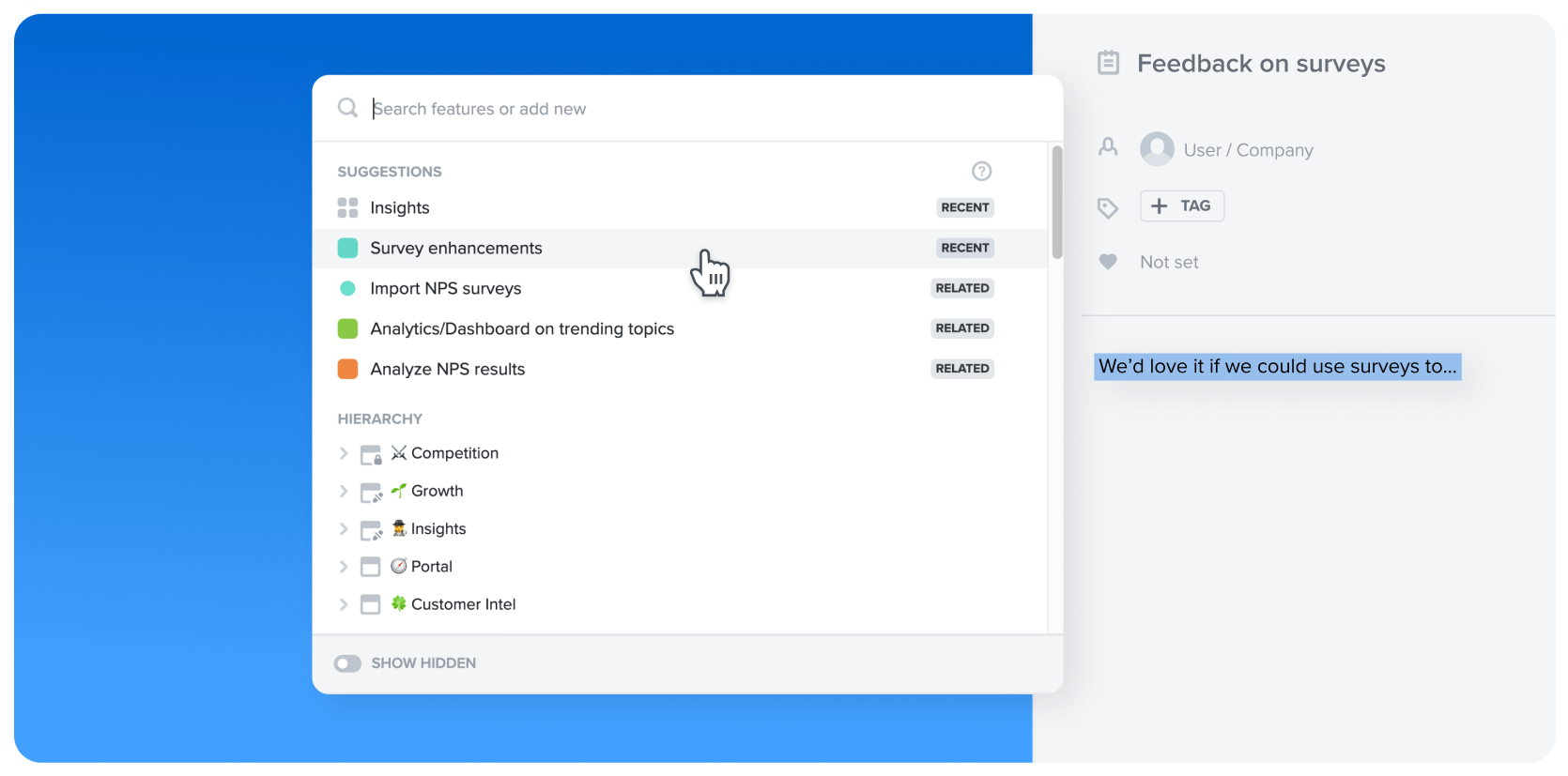
See what’s trending across all your feedback
Now what if your organization has hundreds of pieces of feedback arriving every week and not enough hours in the day to review it all? 2022 also saw the launch of Productboard’s Insights trends, a dashboard that shows product leaders, product ops, product makers, and user researchers how your feedback is trending. See how feedback volumes are fluctuating over time, which customer segments are providing the most feedback, which features and product areas are receiving the most feedback, and which tags are being used the most.
Now you can even see recurring topics that Productboard has intelligently detected across tens, hundreds, or thousands of feedback notes. You can even refine these topics further by specifying related keywords to continuously improve Productboard’s capabilities for automatically categorizing your feedback.
Learn more: Insights trends | Smart topic detection
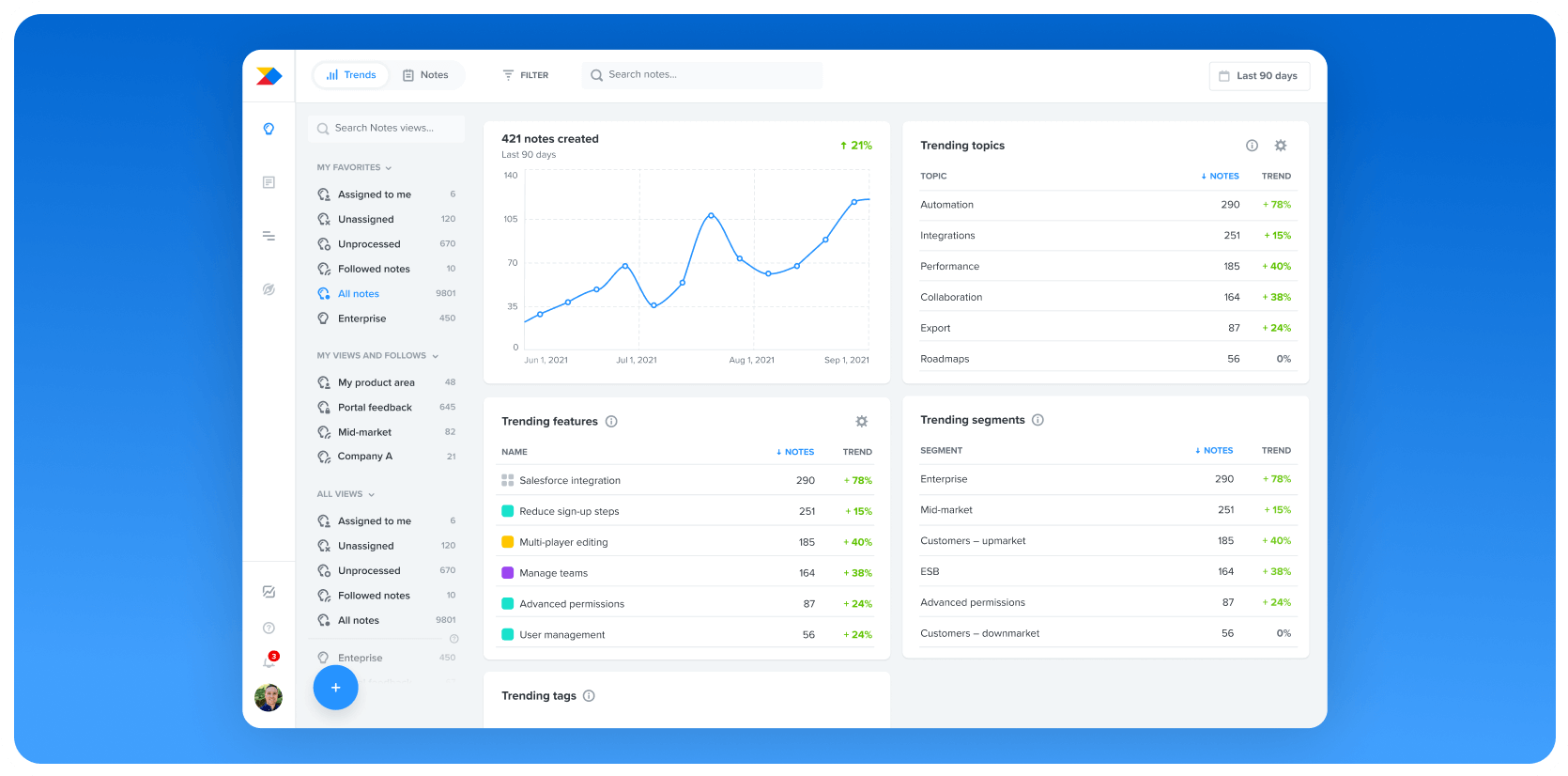
Prioritize what your target customer segment really needs
Of course, not all feedback should be treated equally. What are your most important customers asking for? With Productboard’s latest segmentation capabilities, now you can answer that question! Last year we shipped the Salesforce integration which lets you define customer segments in Productboard based on company attributes like the number of paid seats, how much money they’re paying you, company size, industry, or other firmographic data. Now you can also define user segments based on cohorts defined around product usage in analytics solutions like Amplitude and Mixpanel. For example, this could help you zero in on the needs of your new users, power users, or early adopters of your newest product or feature. That way you can build what matters most, to your customers who matter most, to the success of your business.
Learn more: Integrate with Amplitude | Integrate with Mixpanel
Track any customer’s needs and provide tailored updates
Productboard’s new Customer board provides an overview of each user and company so you can see what they’ve requested in the past, and what progress your team has made toward addressing their needs. You can also access additional data about customers here, including attributes brought in from your CRM. All this information is invaluable if you’re reviewing the needs of your VIP customers, preparing for a quarterly business review with a customer, or looking to recruit the right customers for user research, a beta program, a testimonial, or your customer advisory board.
Naturally, it’s not just product makers and leaders who will benefit from this information. Customer success managers and account managers have long struggled to capture information on user needs, past requests, and product team progress in traditional customer success platforms. Now they can use Productboard to help manage their book of business, delight customers to drive renewals, and help retain key accounts.
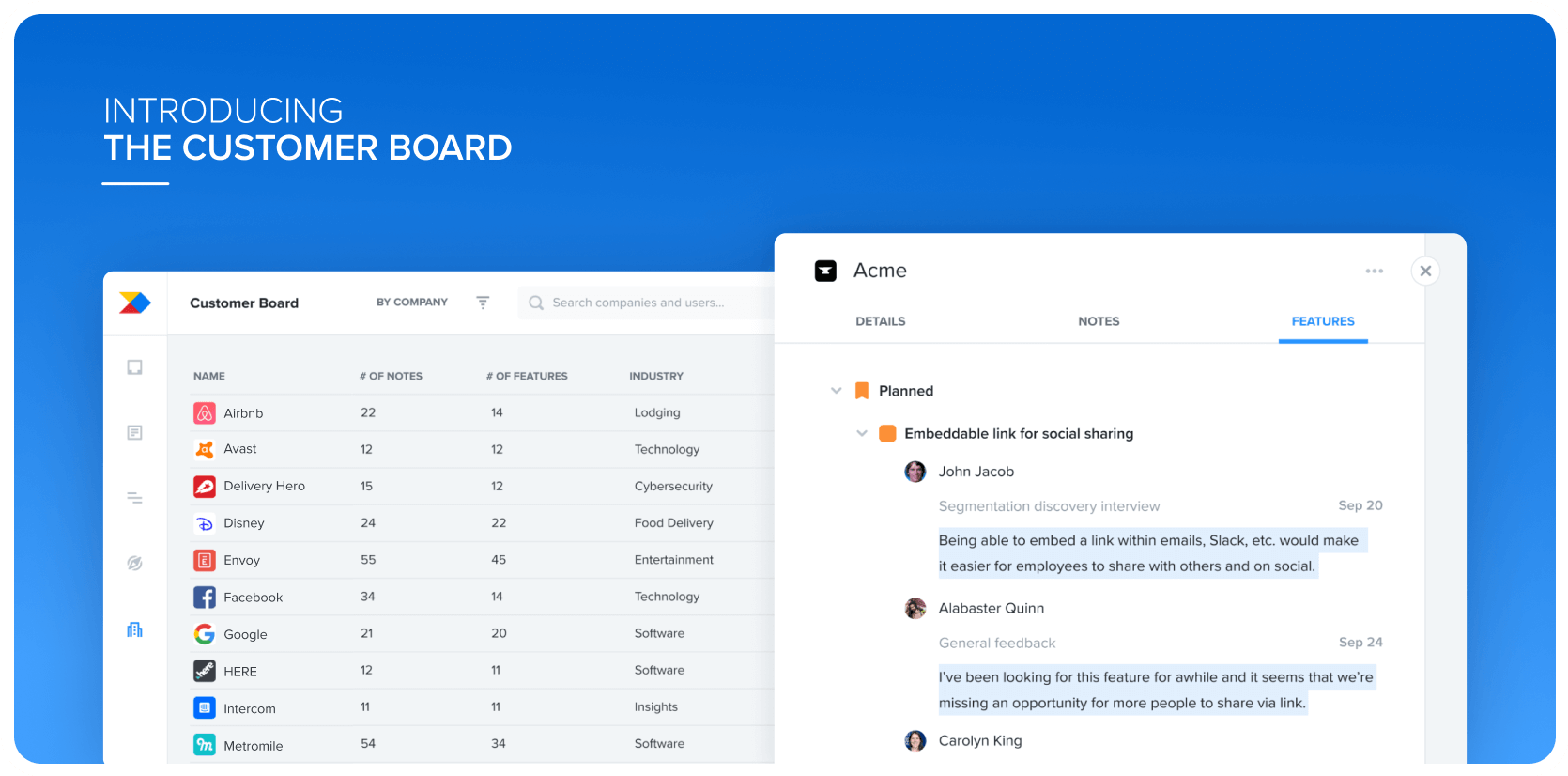
See what every feature idea is worth ($) to your business
Product managers have always dreamed of being able to attach a dollar amount to every feature idea: “What revenue could we expect to gain or retain by building this feature?” With aggregated company fields, you can aggregate any numerical field associated with customer companies in your workspace (such as how much money they’re paying you) and see a total value for each feature idea — based on which features each company has requested.
In the past, you could use the Opportunity value field to calculate how much revenue each feature could help you generate from closing new opportunities. With the new aggregated company fields, this can be done for all your customers.
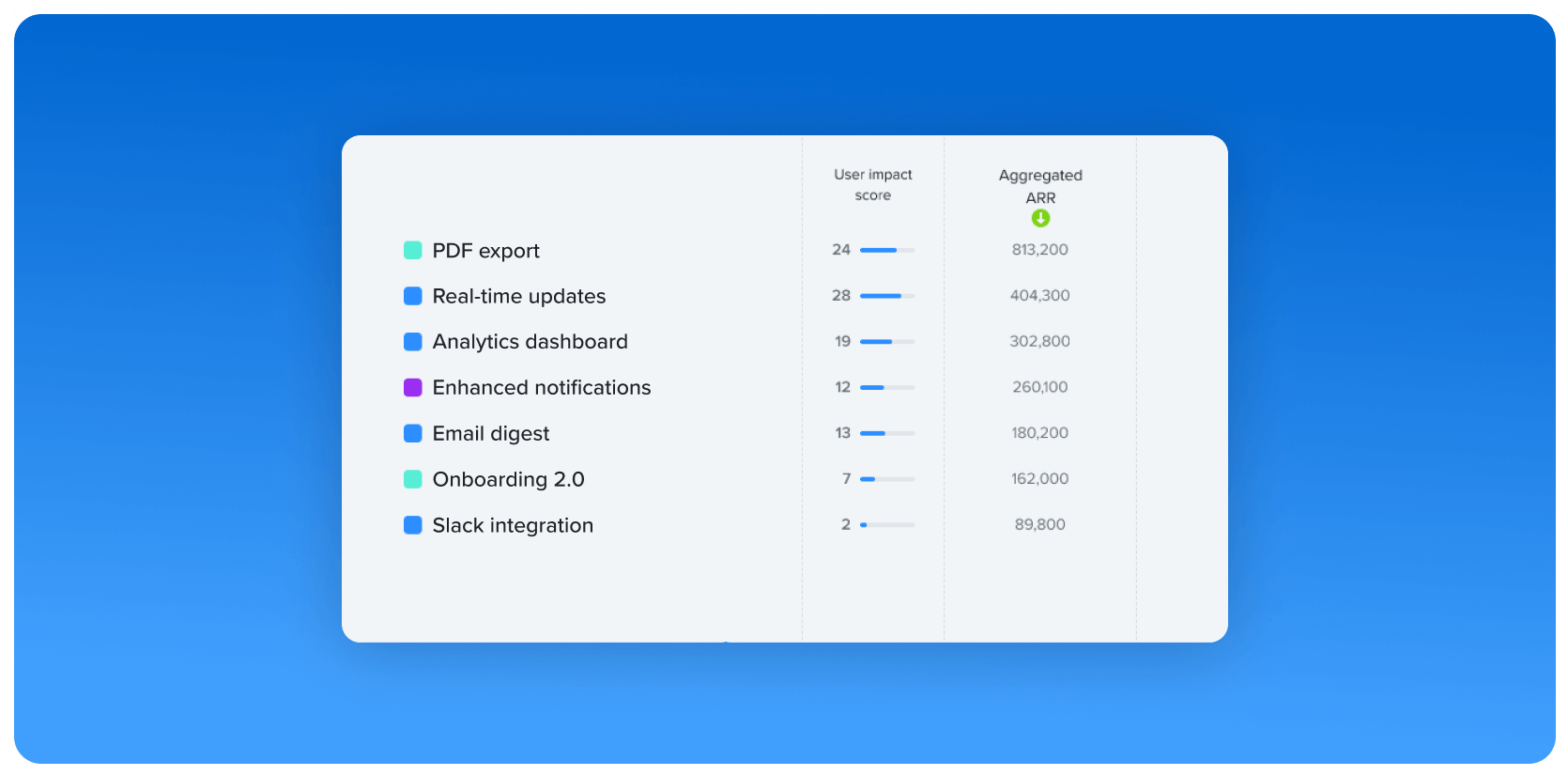
Make data-driven prioritization decisions with custom formulas
Productboard also offers new customizable formulas you can use to standardize your organization’s prioritization processes and make more data-driven decisions. You can define formulas based on popular prioritization frameworks (RICE, WSJF, ROI), or customize them to create your own. In addition to rolling up custom number fields into scores, you can also factor in the user impact score (e.g. to represent the “impact” value in a RICE score) and the effort field (e.g. to serve as the denominator of a value/effort ratio). All these updates will help your team take a more systematic approach to deciding the right features to work on next — features that will have an impact on your customers and your business.
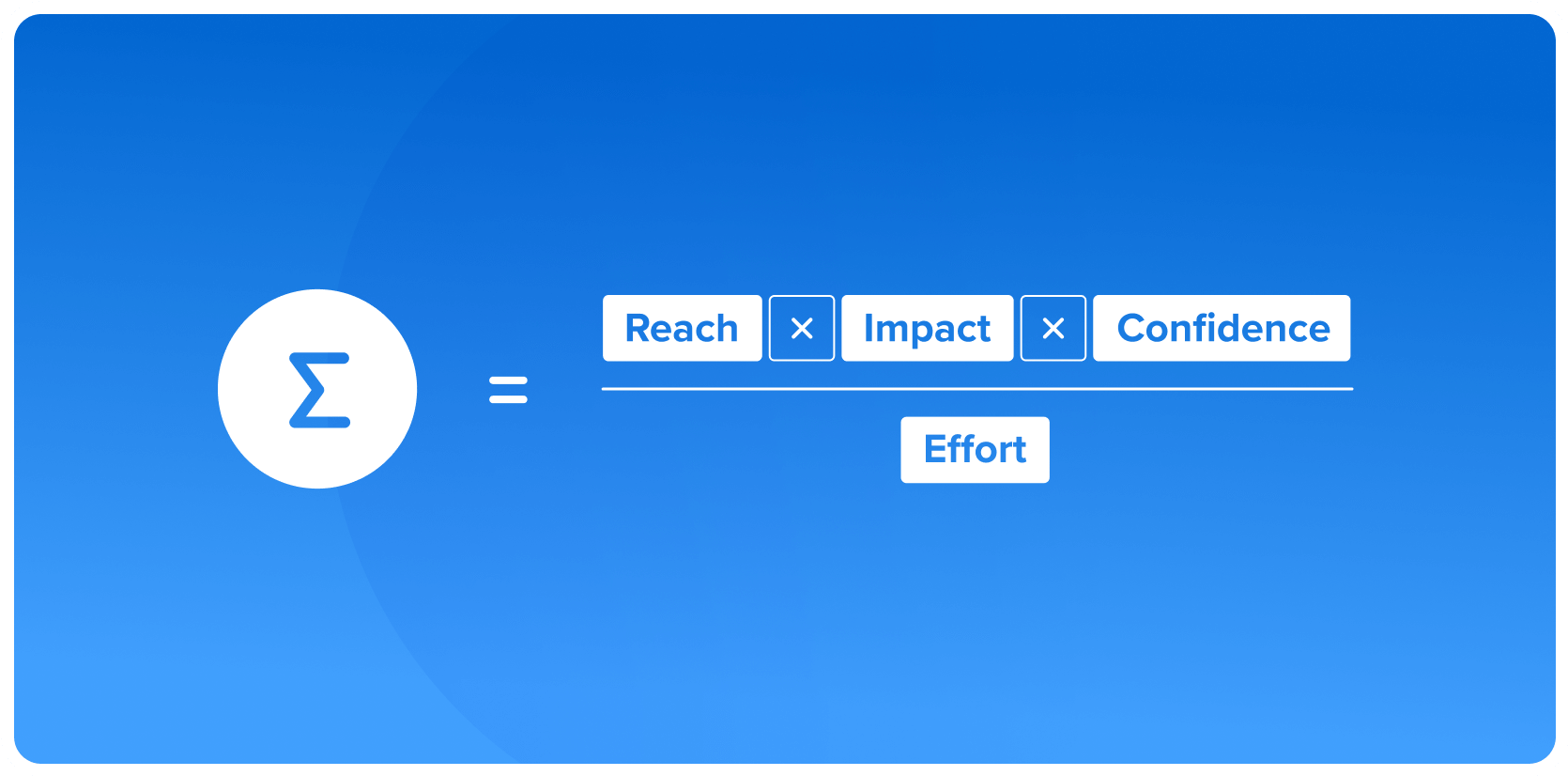
Maximize productivity and alignment across your product organization
This year, we also challenged ourselves to help product leaders and product ops who are striving to make product teams more efficient and effective. With this in mind, we launched new Reports to help your teams continuously improve and get maximum value from Productboard. Below you’ll also find information on our latest Jira integration enhancements that will make product managers more productive and keep product and delivery teams aligned!
Remove bottlenecks with efficiency reports
Efficiency reports help you get features to market faster by answering questions like these:
- How long does it take to deliver features on average?
- Is my product organization becoming more or less efficient over time?
- As features progress from conception to launch, where are they getting held up the longest?
- Within each status/phase, which features have been there the longest and who’s working on them?
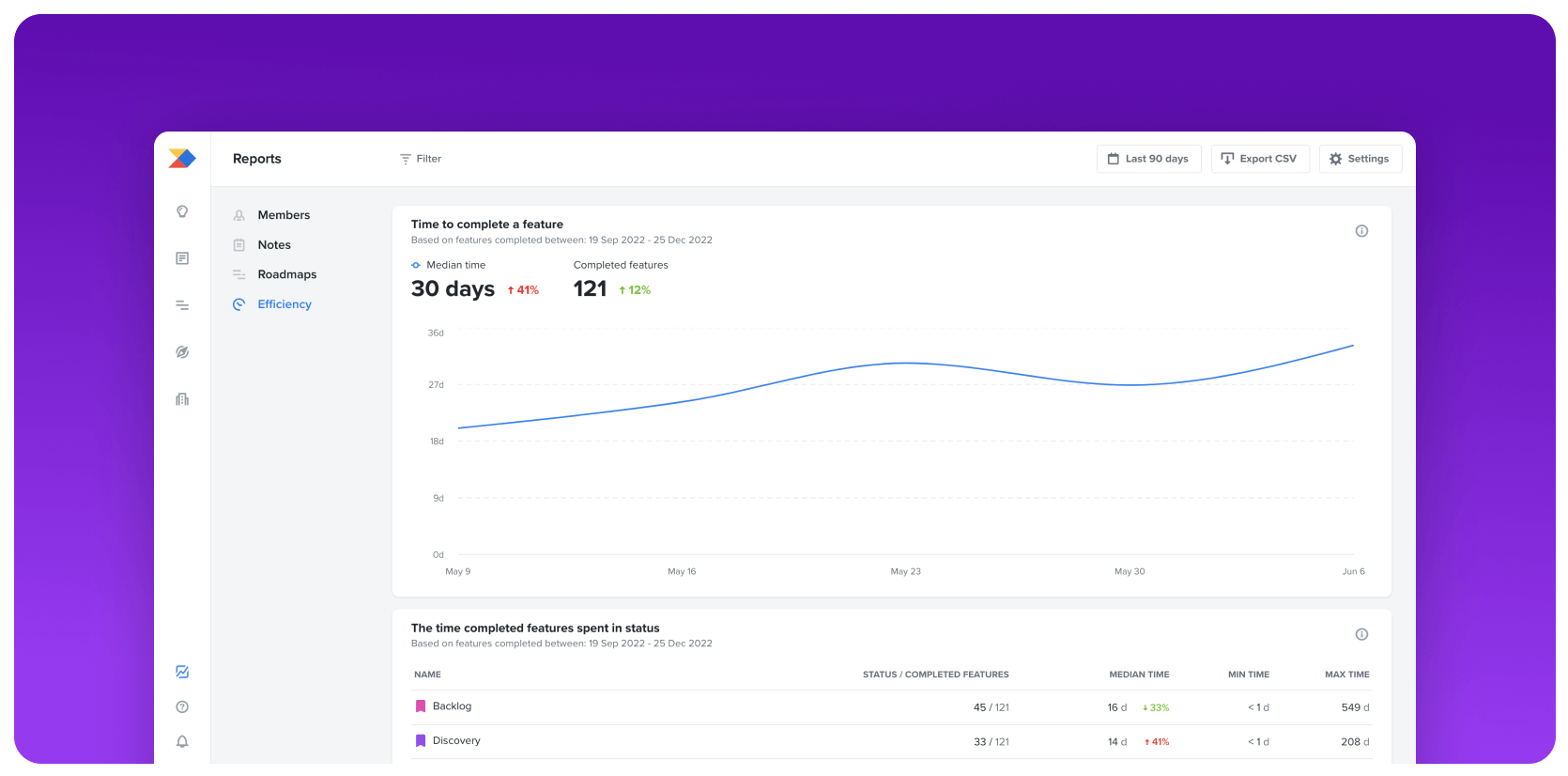
Ensure every team is working on what matters with allocation reports
Allocation reports help product leaders ensure teams are working on what’s most important by answering questions like these:
- How many features have you shipped within each objective, theme, or product area?
- How much effort have you expended toward each objective, theme, or product area?
- At a glance, how much work being done falls outside of your stated areas of focus?
- Within each area of focus, what features have been worked on, who owns them, and how much effort did they require?
Allocation reports are now in beta, coming soon to general availability. Learn more
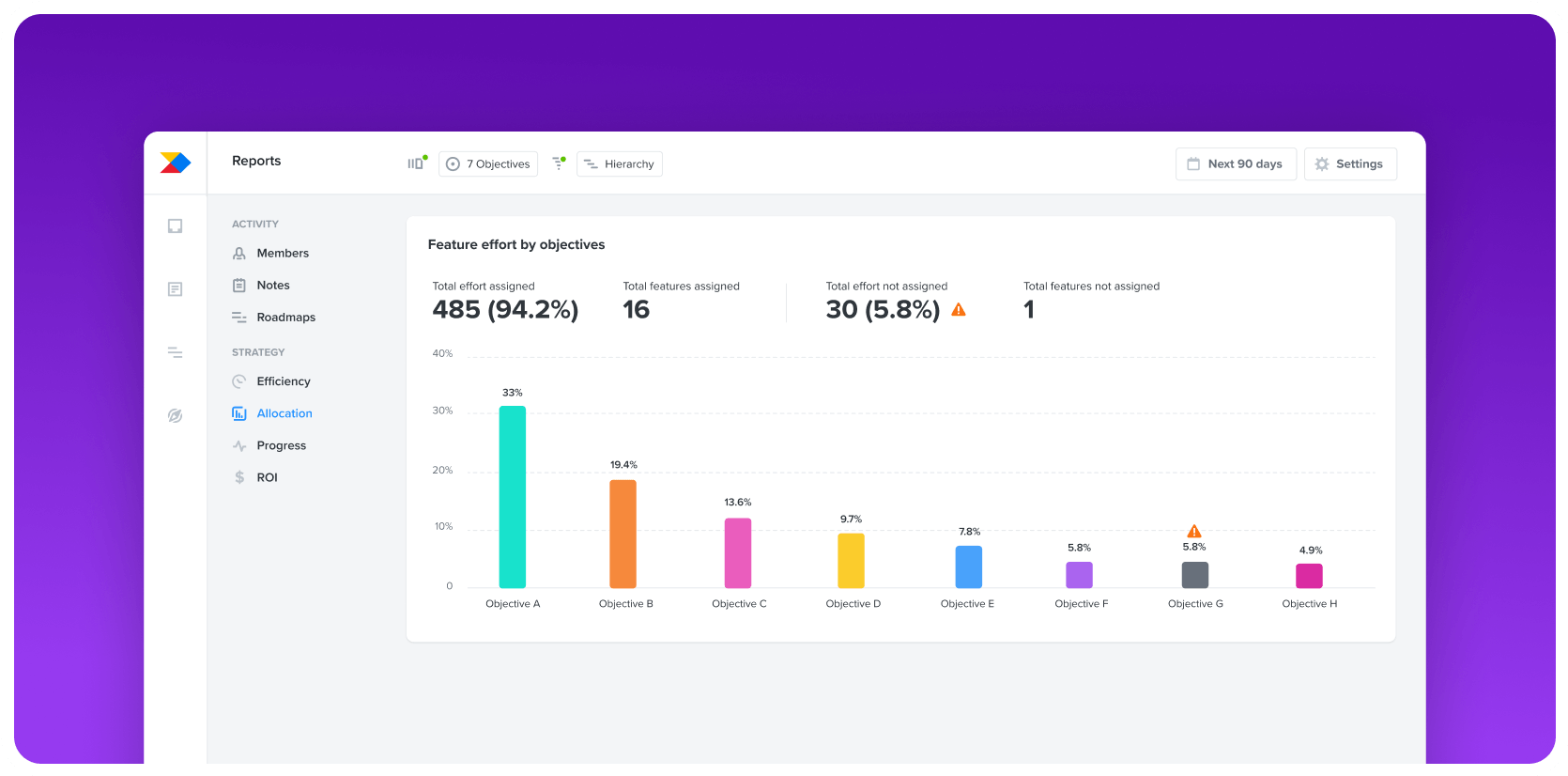
Get the most value out of Productboard with usage reports
Usage reports help product operations ensure teams are using Productboard most effectively by answering questions like these:
- How active are your makers and contributors in Productboard?
- From which sources are most of your feedback coming from?
- Are product teams able to stay on top of reviewing and categorizing incoming feedback?
- How many colleagues have visited your roadmaps lately and how is this trending? Who is using them the most?
- Which roadmaps are receiving the most traffic?
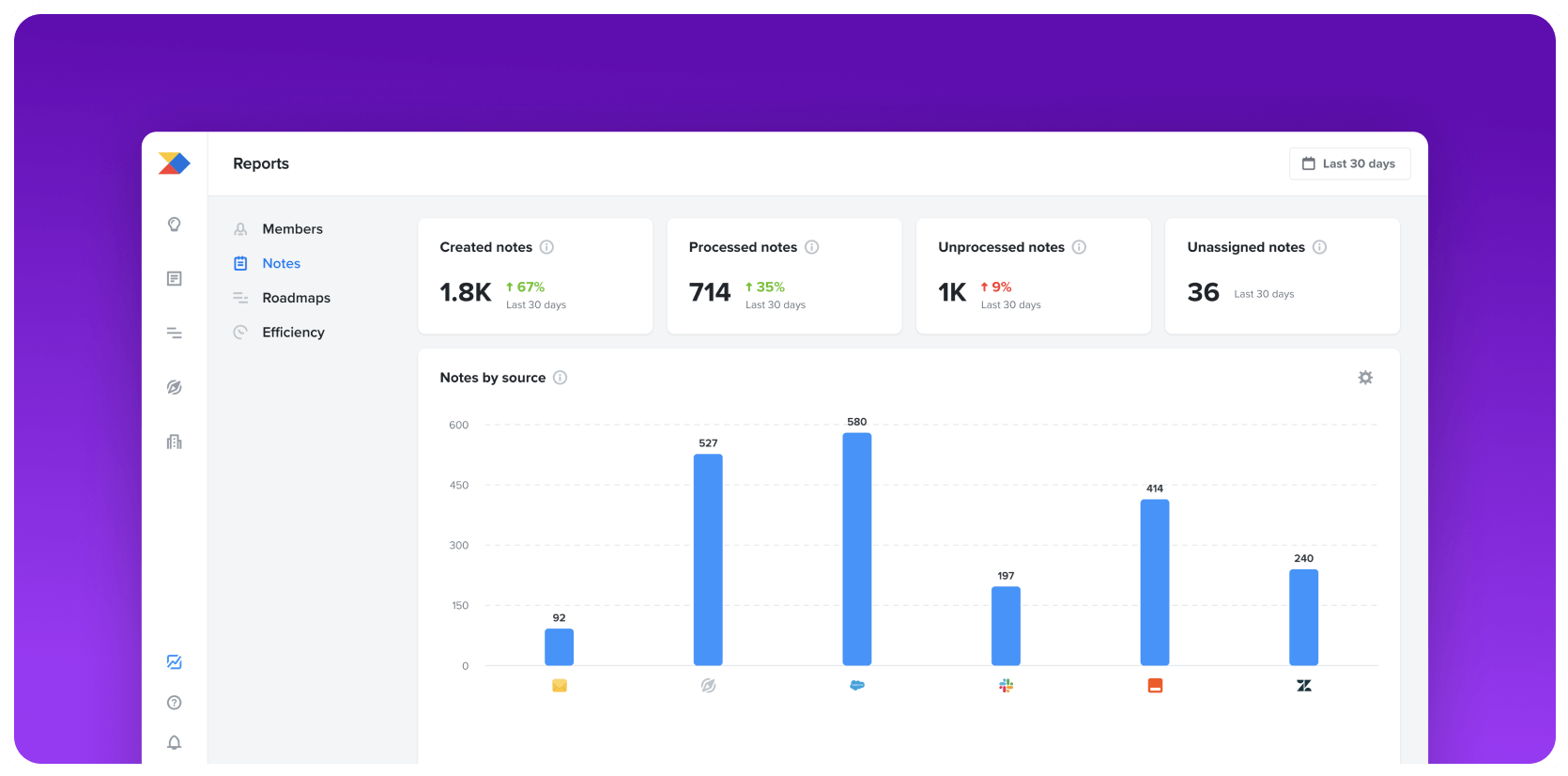
Drive product-engineering alignment with an enhanced Jira integration
With the latest rounds of enhancements, Productboard’s Jira integration is more flexible than ever. That will save product managers valuable time while ensuring product and delivery teams stay aligned.
New status mapping allows you to dictate which Jira statuses (e.g. delivery backlog, in progress, under review) map to which Productboard statuses (e.g. in progress). When a feature gets pushed into Jira, its status will automatically update in Productboard as its associated issue progresses through delivery.
Field mapping improvements give you more control over which data fields are synced between Productboard and Jira. In addition to mapping custom fields, you can also now map native fields like feature name, description, owner, or timeframe. And it’s up to you whether fields stay synced across both systems or whether they sync on a one-time basis (i.e. when a feature gets pushed into Jira) but can be updated individually thereafter.
If you administer the Jira integration for your organization, make sure to take a spin through Productboard’s integration settings page and look out for other new settings that might benefit your team.
Check out our new and improved Jira documentation
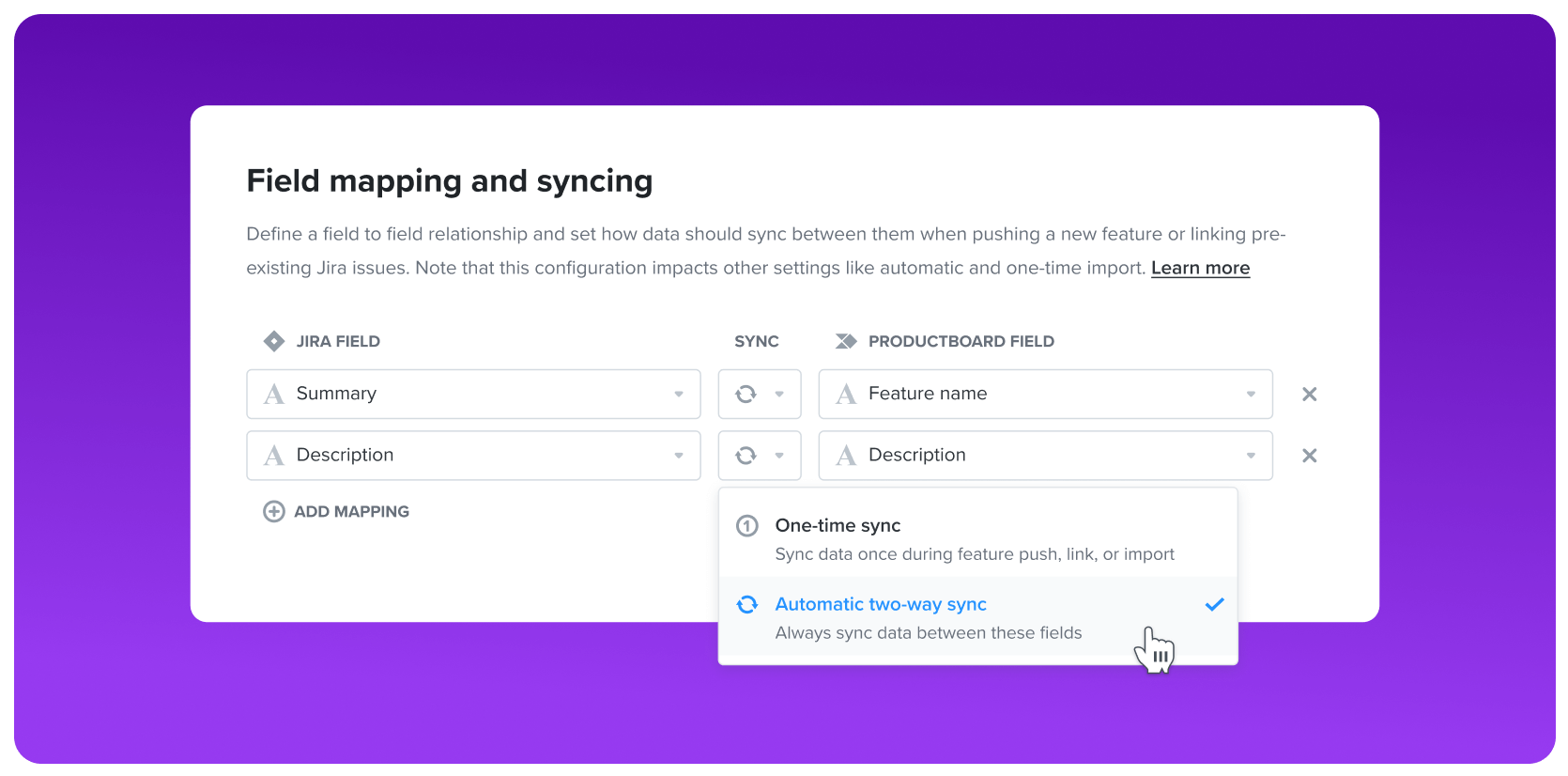
Invest everyone in where you’re taking your product
Productboard has long focused on helping product managers create beautiful roadmaps in minutes that always stay up-to-date because they’re synced with your plans. With the latest enhancements, Productboard’s roadmaps are now even more interactive and can be used to earn buy-in from more types of stakeholders.
Share your roadmaps with all of your stakeholders and customers
Whether you have certain stakeholders not invited into Productboard, external partners, or customers who would benefit from seeing your product plans, you can now share roadmaps externally with a public link or embed them in a webpage or web application (like Notion, Confluence, or Salesforce). You can even embed a roadmap within your own application to share with all your customers.
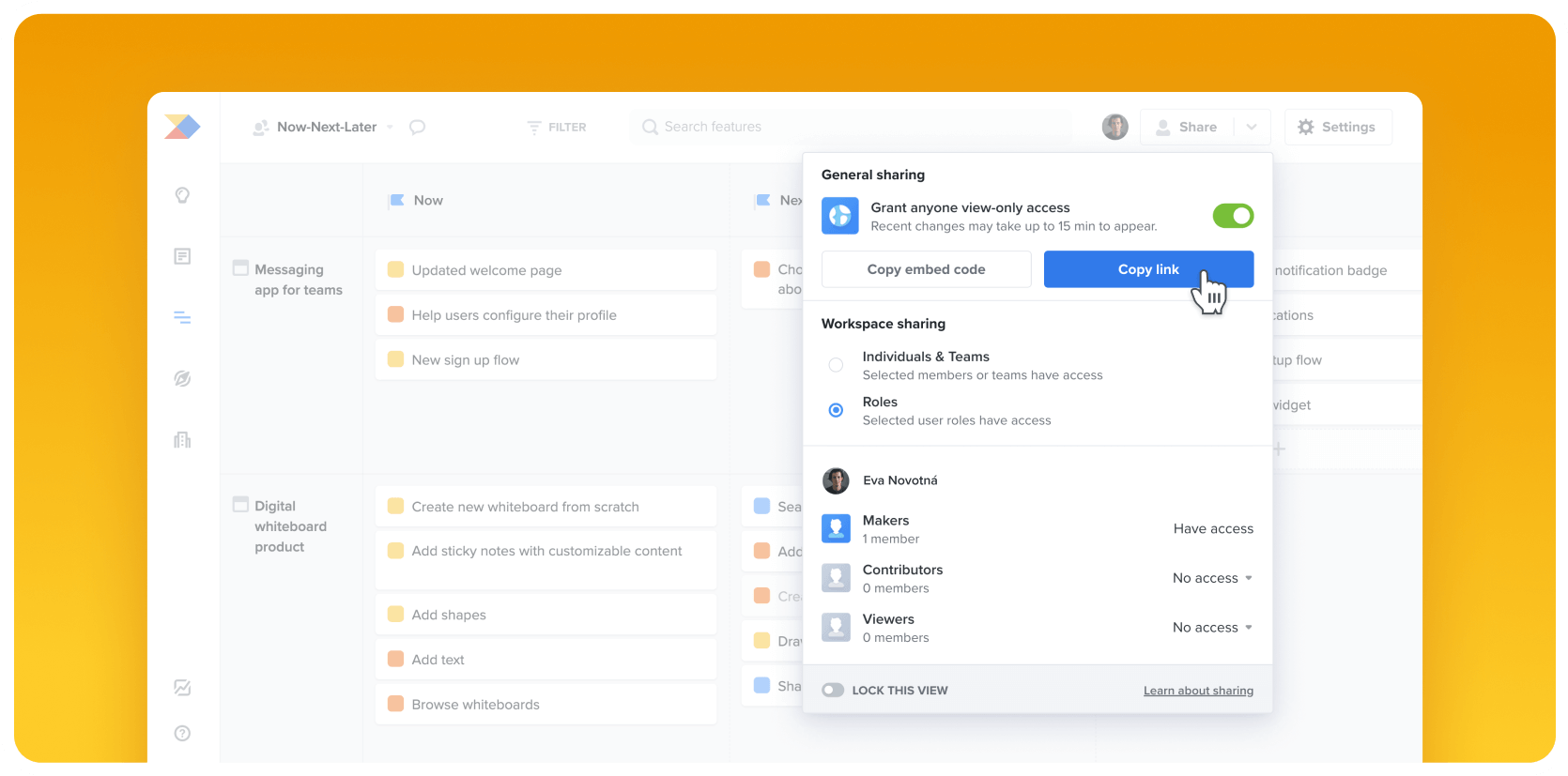
Scale your roadmap presentations with Loom recordings
You can now communicate your product vision through engaging, pre-recorded Loom videos that can be attached directly to any roadmap. It means you’ll spend less time giving one-off roadmap presentations while colleagues around the world can access or rewatch your roadmap recording at any time.
Track feature progress on roadmaps
You can now visualize progress bars on objectives, releases, and features, directly on the roadmap. Progress can be calculated automatically (based on percent completion of underlying features or subfeatures) or manually (based on a percent value you specify).
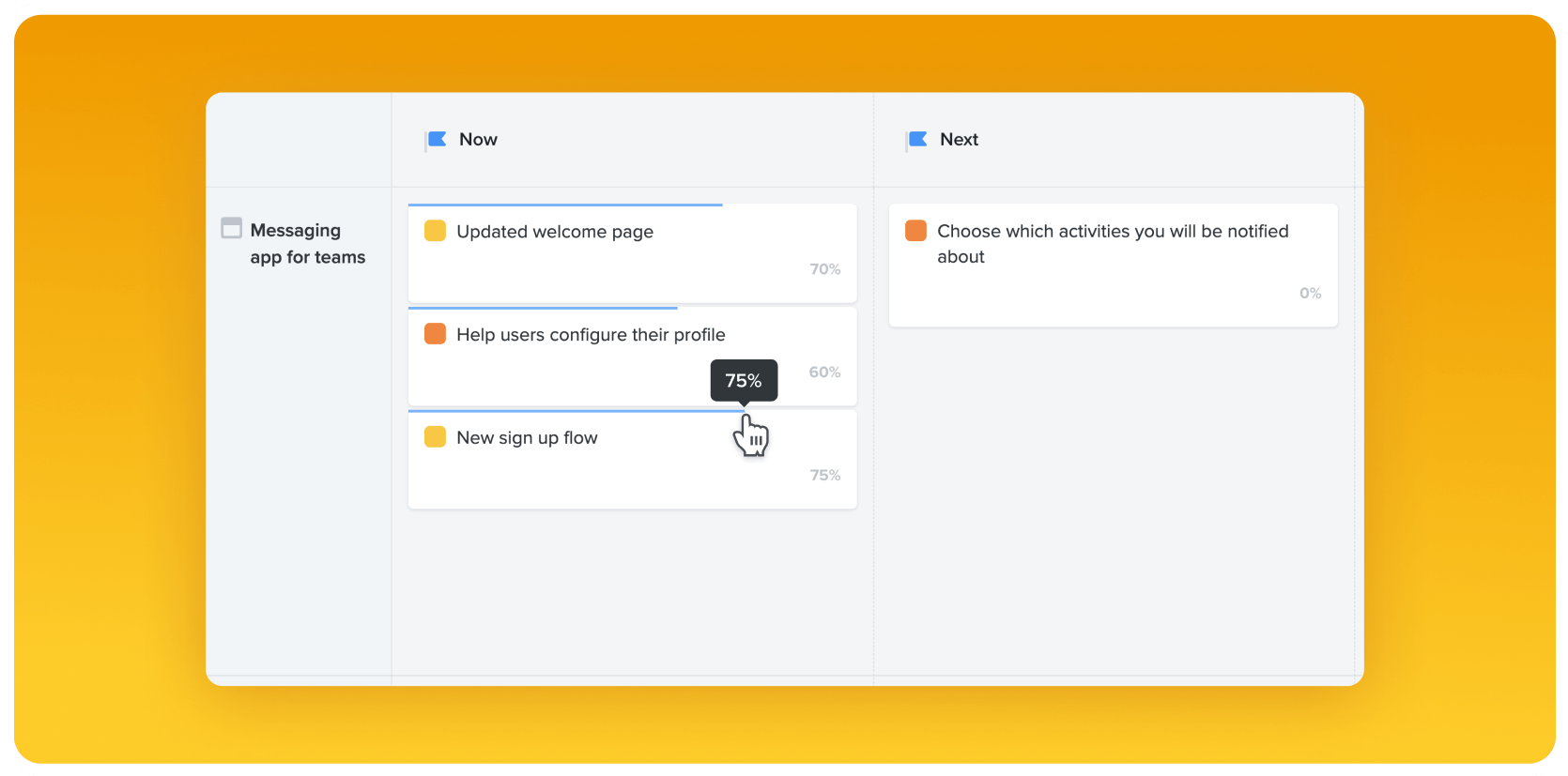
Additional roadmapping enhancements
Don’t miss these additional small but mighty roadmapping enhancements!
- Stakeholders can now comment directly on roadmaps (available in Labs). Learn more
- Review each roadmap’s visitors from the past 30 days. Learn more
- Subfeatures can now be assigned timeframes and dependencies. Learn more
- Owners of roadmaps/views can now lock them to prevent editing by other makers. Learn more
Looking to 2023 and beyond
For an even more detailed look into what we launched this year, check out Productboard’s Portal, where you can also provide feedback on all the major features we’ve released. You’ll also find information on what Team Productboard is working on next.
Looking ahead, we remain committed to helping your organization get the right products to market faster amid this challenging economic climate. We have some big plans for 2023, including exciting updates coming to Productboard’s main navigation and information architecture that will help everyone — product makers, close collaborators, and stakeholders alike — immediately access the product data that matters most to them and collaborate more effectively. We’ll also be unlocking new ways to customize many of the entities in Productboard to match your organization’s processes. (Smart defaults and best practices will still be available!) And look forward to new ways to plan your work, from your top-level strategy, objectives, and initiatives, down to the opportunities and feature ideas you’ve prioritized to work on next.
From our team of product makers to yours, a sincere thank you for being on this journey with us. Wishing you a restful holiday and a strong start to the New Year!
[ad_2]
Source link









